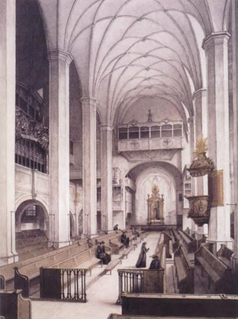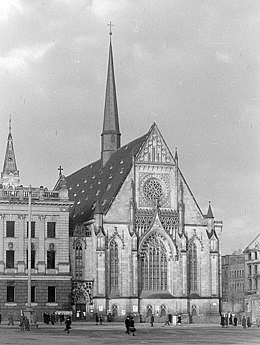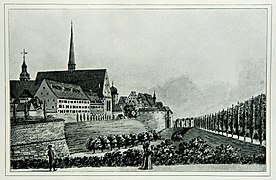Throughout his life as a musician, Johann Sebastian Bach composed cantatas for both secular and sacred use. His church cantatas are cantatas which he composed for use in the Lutheran church, mainly intended for the occasions of the liturgical year.

St. Thomas Church is a Lutheran church in Leipzig, Germany. It is associated with several well-known composers such as Richard Wagner and Felix Mendelssohn Bartholdy, and especially Johann Sebastian Bach, who worked here as a Kapellmeister from 1723 until his death in 1750. Today, the church also holds his remains. Martin Luther preached here in 1539.

The cantatas composed by Johann Sebastian Bach, known as Bach cantatas, are a body of work consisting of over 200 surviving independent works, and at least several dozen that are considered lost. As far as known, Bach's earliest cantatas date from 1707, the year he moved to Mühlhausen, although he may have begun composing them at his previous post in Arnstadt. Most of Bach's church cantatas date from his first years as Thomaskantor and director of church music in Leipzig, a position which he took up in 1723.

Jesus nahm zu sich die Zwölfe, BWV 22, is a church cantata by Johann Sebastian Bach composed for Quinquagesima, the last Sunday before Lent. Bach composed it as an audition piece for the position of Thomaskantor in Leipzig and first performed it there on 7 February 1723.

Du wahrer Gott und Davids Sohn, BWV 23, is a church cantata by Johann Sebastian Bach. He composed it in Köthen between 1717 and 1723 for Quinquagesima Sunday and performed it as an audition piece for the position of Thomaskantor in Leipzig on 7 February 1723. The Sunday was the last occasion for music at church before the quiet time of Lent.

Darzu ist erschienen der Sohn Gottes, BWV 40, is a church cantata by Johann Sebastian Bach. He composed it in 1723, his first year in Leipzig, for the Second Day of Christmas, and first performed it on 26 December that year in both main churches, Thomaskirche and Nikolaikirche. It was the first Christmas cantata Bach composed for Leipzig. The title of the cantata also appears in more modern German as Dazu ist erschienen der Sohn Gottes.

The Augusteum was a building on the Augustusplatz in Leipzig, Germany, to the left of the Paulinerkirche. It was built on the original site of the University of Leipzig and served as its main building.

Sehet, welch eine Liebe hat uns der Vater erzeiget, BWV 64, is a church cantata by Johann Sebastian Bach. He composed the Christmas cantata in Leipzig in 1723 for the third day of Christmas, which is also the Feast of John the Evangelist, and first performed it on 27 December 1723.

Johann Sebastian Bach composed the church cantata Die Himmel erzählen die Ehre Gottes, BWV 76 in Leipzig for the second Sunday after Trinity of the liturgical year and first performed it on 6 June 1723.

Der Geist hilft unser Schwachheit auf, BWV 226, is a motet by Johann Sebastian Bach, composed in Leipzig in 1729 for the funeral of Johann Heinrich Ernesti.

Thomaskantor is the common name for the musical director of the Thomanerchor, now an internationally known boys' choir founded in Leipzig in 1212. The official historic title of the Thomaskantor in Latin, Cantor et Director Musices, describes the two functions of cantor and director. As the cantor, he prepared the choir for service in four Lutheran churches, Thomaskirche, Nikolaikirche, Neue Kirche and Peterskirche. As director, he organized music for city functions such as town council elections and homages. Functions related to the university took place at the Paulinerkirche. Johann Sebastian Bach was the most famous Thomaskantor, from 1723 to 1750.

Johann Sebastian Bach composed the church cantata Nimm von uns, Herr, du treuer Gott, BWV 101 in Leipzig for the tenth Sunday after Trinity and first performed it on 13 August 1724. The chorale cantata is based on the hymn by Martin Moller (1584).
There are 52 chorale cantatas by Johann Sebastian Bach surviving in at least one complete version. Around 40 of these were composed during his second year as Thomaskantor in Leipzig, which started after Trinity Sunday 4 June 1724, and form the backbone of his chorale cantata cycle. The eldest known cantata by Bach, an early version of Christ lag in Todes Banden, BWV 4, presumably written in 1707, was a chorale cantata. The last chorale cantata he wrote in his second year in Leipzig was Wie schön leuchtet der Morgenstern, BWV 1, first performed on Palm Sunday, 25 March 1725. In the ten years after that he wrote at least a dozen further chorale cantatas and other cantatas that were added to his chorale cantata cycle.

Johann Sebastian Bach composed the church cantata Es reißet euch ein schrecklich Ende, BWV 90, in Leipzig for the 25th Sunday after Trinity and first performed it on 14 November 1723.
In Johann Sebastian Bach's time, the election or inauguration of a new town council, normally an annual event, was celebrated with a church service. A cantata written for such occasion was indicated with the term Ratswahl or Ratswechsel. Bach composed such cantatas for Mühlhausen and for Leipzig. Five of these cantatas are entirely extant. One further cantata, BWV 193.2, lost part of its music, and there are another five that have only been known to exist, or for which only the text is extant.
A church cantata or sacred cantata is a cantata intended to be performed during a liturgical service. The liturgical calendar of the German Reformation era had, without counting Reformation Day and days between Palm Sunday and Easter, 72 occasions for which a cantata could be presented. Composers such as Georg Philipp Telemann composed cycles of church cantatas comprising all 72 of these occasions. Such a cycle is called an "ideal" cycle, while in any given liturgical year feast days could coincide with Sundays, and the maximum amount of Sundays after Epiphany and the maximum amount of Sundays after Trinity could not all occur.

Jauchzet, frohlocket! Auf, preiset die Tage, BWV 248I, is a 1734 Christmas cantata by Johann Sebastian Bach that serves as the first part of his Christmas Oratorio. Bach was then Thomaskantor, responsible for church music at four churches in Leipzig, a position he had assumed in 1723. For the oratorio, the libretto by an unknown author followed the nativity of Jesus from the Gospel of Luke, interspersed with reflecting texts for recitatives and arias, and stanzas from Lutheran hymns.

Leipziger Universitätsmusik refers to music education and performance at the University of Leipzig. Music at the university dates back to its founding of the university in the 15th century. At present, Leipziger Universitätsmusik is the name of several musical ensembles formed by students and professors, and supported by professional musicians, the choir Leipziger Universitätschor, an orchestra, two smaller instrumental ensembles, and a big band.

Und es waren Hirten in derselben Gegend, BWV 248II, is a 1734 Christmas cantata by Johann Sebastian Bach as the second part of his Christmas Oratorio. Bach was then Thomaskantor, responsible for music at four churches in Leipzig, a position he had assumed in 1723.
Herrscher des Himmels, erhöre das Lallen, BWV 248III, is a 1734 church cantata for the third day of Christmas (27 December) which Johann Sebastian Bach composed as the third part of his Christmas Oratorio. The Christmas cantata was first performed in 1734, in Leipzig.


























